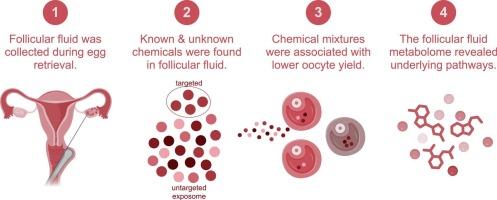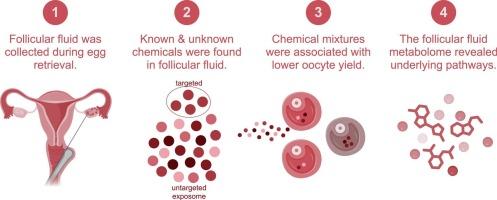Integrated chemical exposome–metabolome profiling of follicular fluid and associations with fertility outcomes during assisted reproduction
IF 9.7
1区 环境科学与生态学
Q1 ENVIRONMENTAL SCIENCES
引用次数: 0
Abstract
Many endocrine-disrupting chemicals have been linked to impaired ovarian function and fertility. However, most research has focused on small numbers of known chemicals in blood or urine. We aimed to measure the untargeted chemical exposome and metabolome in follicular fluid, a more toxicologically relevant reproductive biofluid, and evaluate associations with outcomes of controlled ovarian stimulation. Follicular fluid was collected from 82 patients undergoing egg retrieval for assisted reproduction in Atlanta and analyzed using untargeted gas (GC) and liquid (LC) chromatography with high-resolution mass spectrometry (HRMS). In single-chemical regression and mixture models (weighted quantile sum with random subsets), we estimated associations of chemicals with retrieved oocyte count, adjusted for age, race, smoking, and ovarian stimulation protocol. In over 90% of follicular fluid samples, we detected 82 confirmed exogenous chemicals with known identities as plasticizers, flame retardants, pesticides, per- and polyfluoroalkyl substances, or polycyclic aromatic hydrocarbons. About 3,081 of the untargeted detected features were individually associated with fewer retrieved oocytes after multiple-testing correction. In the GC environmental mixture model, 587 untargeted chemical features were jointly associated with 21% fewer retrieved oocytes (95% CI: −30 %, −12 %) per standard-deviation (SD) increase in exposure, compared to average single-chemical effects of −10 % per SD. Twenty metabolic pathways were associated with chemical mixture indices and oocyte count, including methionine, nicotinamide, glycine, pyrimidine, selenocompounds, tryptophan, phenylacetate, and biopterin metabolism. Our findings suggest that complex chemical mixtures infiltrate oocyte microenvironments and may impair ovarian reserve through diverse mechanisms. Discovery-based untargeted exposomic approaches uncover new exposures of potential concern and highlight the larger effects of cumulative mixtures than any single chemical alone.


辅助生殖过程中卵泡液的综合化学暴露体-代谢组分析及其与生育结果的关系
许多干扰内分泌的化学物质与卵巢功能和生育能力受损有关。然而,大多数研究都集中在血液或尿液中少量已知的化学物质上。我们的目的是测量卵泡液(一种与毒理学更相关的生殖生物液)中的非靶向化学暴露体和代谢组,并评估与控制卵巢刺激结果的关联。从亚特兰大82名接受取卵辅助生殖的患者中收集卵泡液,并采用高分辨率质谱(HRMS)非靶向气相色谱(GC)和液相色谱(LC)分析。在单化学回归和混合模型(随机子集加权分位数和)中,我们估计了化学物质与检索到的卵母细胞计数的关联,并根据年龄、种族、吸烟和卵巢刺激方案进行了调整。在超过90%的卵泡液样本中,我们检测到82种确认的外源性化学物质,它们具有已知的特性,如增塑剂、阻燃剂、杀虫剂、全氟烷基和多氟烷基物质或多环芳烃。在多次检测校正后,约有3,081个非靶向检测特征单独与较少的回收卵母细胞相关。在GC环境混合模型中,587种非靶向化学特征与每标准差(SD)增加暴露量减少21% (95% CI: - 30%, - 12%)相关,而平均单一化学效应为- 10% / SD。20种代谢途径与化学混合物指数和卵母细胞计数相关,包括蛋氨酸、烟酰胺、甘氨酸、嘧啶、硒化合物、色氨酸、苯乙酸酯和生物蝶呤代谢。我们的研究结果表明,复杂的化学混合物渗入卵母细胞微环境,并可能通过多种机制损害卵巢储备。基于发现的非靶向暴露方法揭示了潜在问题的新暴露,并强调了累积混合物比任何单一化学品的更大影响。
本文章由计算机程序翻译,如有差异,请以英文原文为准。
求助全文
约1分钟内获得全文
求助全文
来源期刊

Environment International
环境科学-环境科学
CiteScore
21.90
自引率
3.40%
发文量
734
审稿时长
2.8 months
期刊介绍:
Environmental Health publishes manuscripts focusing on critical aspects of environmental and occupational medicine, including studies in toxicology and epidemiology, to illuminate the human health implications of exposure to environmental hazards. The journal adopts an open-access model and practices open peer review.
It caters to scientists and practitioners across all environmental science domains, directly or indirectly impacting human health and well-being. With a commitment to enhancing the prevention of environmentally-related health risks, Environmental Health serves as a public health journal for the community and scientists engaged in matters of public health significance concerning the environment.
 求助内容:
求助内容: 应助结果提醒方式:
应助结果提醒方式:


